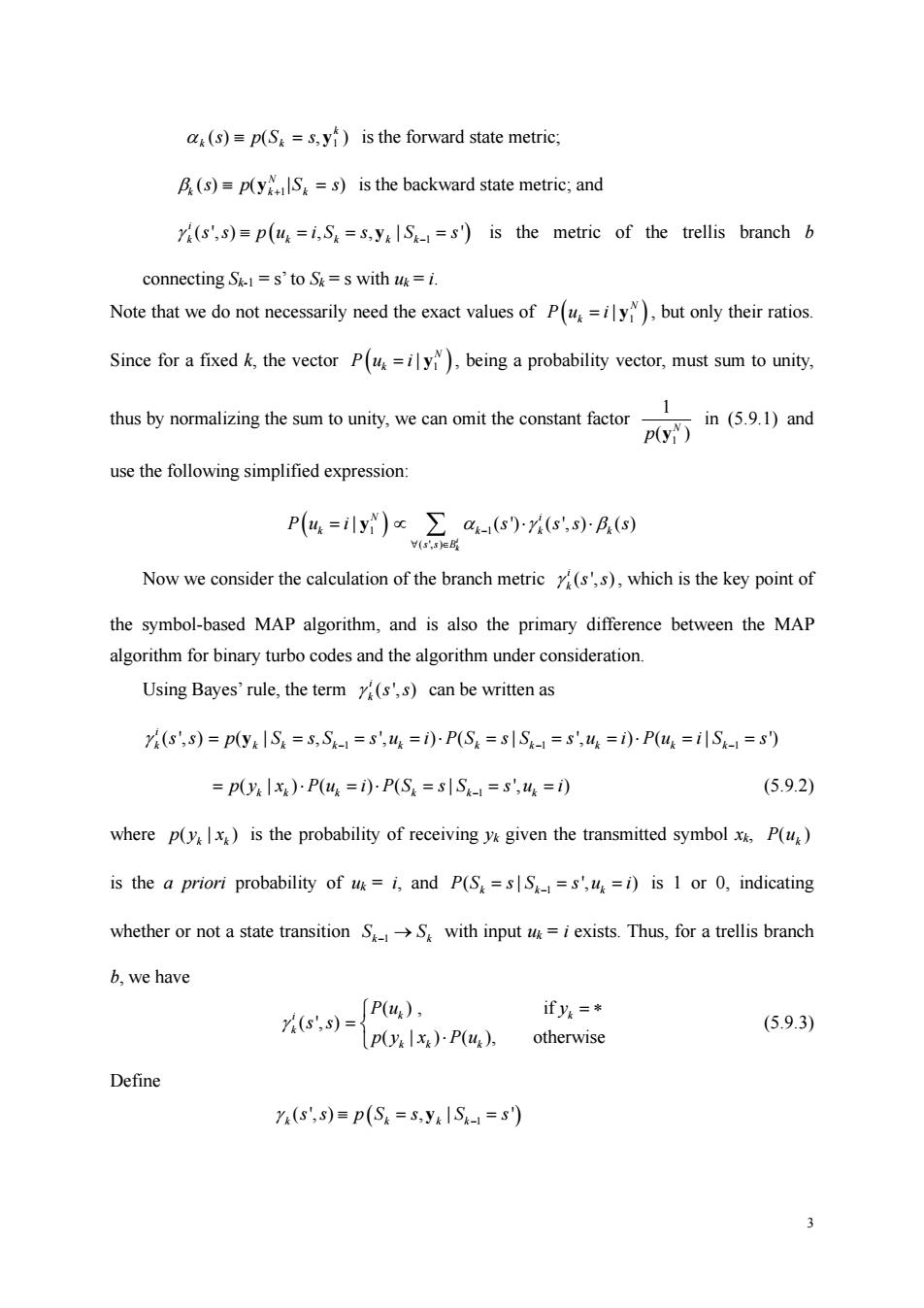正在加载图片...

a(s)=p(S=s.y)is the forward state metric. B(s)=p(y=s)is the backward state metric;and (s',s)=p(ug=i.S.=s.yS=s')is the metric of the trellis branch b connecting S=s'to S=s with us=i. Note that we do not necessarily need the exact values of P(=ily,but only their ratios. Since for a fixedk,the vector P(y),being a probability vector,must sum to unity, thus by normalizing the sum to unity,we can omit the constant factor p(y in (5.9.1)and use the following simplified expression P(u =ily)>a(s)-n(s'.s)B(s) ( Now we consider the calculation of the branch metric(s's),which is the key point of the symbol-based MAP algorithm,and is also the primary difference between the MAP algorithm for binary turbo codes and the algorithm under consideration. Using Bayes'rule,the term(s'.s)can be written as (s',s)=pyS=3,S-1=S',4=)PS=sS=',4=)P(u=iS-=s) =p(yx)P(u=i)-P(S.=sIS=s'.u=i) (5.9.2) where p()is the probability of receivingy given the transmitted symbol x P() is the a priori probability of ug=i,and P(S=sS=s',=i)is 1 or 0,indicating whether or not a state transition SS with input=i exists.Thus,for a trellis branch b,we have 2s,=P4), ify=* x)P(u). (5.9.3) otherwise Define r(s,s)=p(S=s,yIS-=s) 3 3 α k k k () ( , ) s pS s ≡ = y1 is the forward state metric; βk k N k () ( | ) sp Ss ≡ = y +1 is the backward state metric; and ( ) 1 ( ', ) , , | ' i k k k kk γ s s pu iS s S s ≡ == = − y is the metric of the trellis branch b connecting Sk-1 = s’ to Sk = s with uk = i. Note that we do not necessarily need the exact values of ( | 1 ) N Pu i k = y , but only their ratios. Since for a fixed k, the vector ( ) 1 | N Pu i k = y , being a probability vector, must sum to unity, thus by normalizing the sum to unity, we can omit the constant factor 1 1 ( ) N p y in (5.9.1) and use the following simplified expression: ( ) 1 | N Pu i k = y 1 ( ', ) ( ') ( ', ) ( ) i k i kk k ss B αγ β s ss s − ∀ ∈ ∝ ⋅⋅ ∑ Now we consider the calculation of the branch metric ( ', ) i k γ s s , which is the key point of the symbol-based MAP algorithm, and is also the primary difference between the MAP algorithm for binary turbo codes and the algorithm under consideration. Using Bayes’ rule, the term ( ', ) i k γ s s can be written as ( ', ) i k γ s s 1 11 ( | , ', ) ( | ', ) ( | ') kk k k k k k k k p S sS s u i PS s S s u i Pu i S s = = = =⋅ = = =⋅ = = − −− y 1 ( | ) ( ) ( | ', ) kk k k k k p y x Pu i PS s S s u i = ⋅ =⋅ = = = − (5.9.2) where ( | ) k k p y x is the probability of receiving yk given the transmitted symbol xk, P uk ( ) is the a priori probability of uk = i, and 1 ( | ', ) PS s S s u i kk k = − = = is 1 or 0, indicating whether or not a state transition k k 1 S S − → with input uk = i exists. Thus, for a trellis branch b, we have ( ', ) i k γ s s ( ) , if ( | ) ( ), otherwise k k kk k Pu y p y x Pu ⎧ = ∗ = ⎨ ⋅ ⎩ (5.9.3) Define ( ) 1 ( ', ) , | ' k k kk γ ss pS s S s ≡= = − y